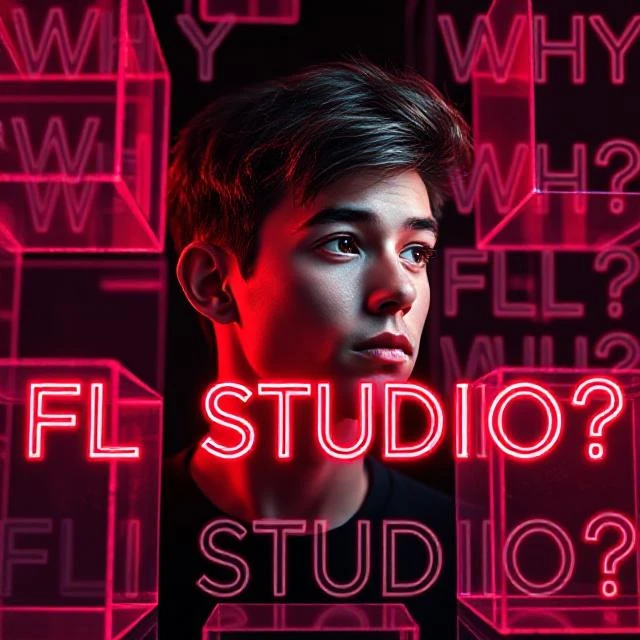Why I’ll Stick With FL Studio Forever

If you’ve ever watched a DJ accidentally knock over a mixer mid-set, only to recover with a drop that blows the roof off, you’ve witnessed the magic of controlled chaos. That’s FL Studio for me—a beautiful, unpredictable playground where my dance music dreams come to life. Here’s why, after over a decade, I’m still headlining my relationship with this DAW (and why we’re basically married at this point).
The Accidental First Date (and How FL Studio Dropped the Beat)
Let’s rewind to 2011. I was a broke college student with a pirated copy of FL Studio 10 (forgive me, Image-Line—I’ve since bought three licenses to atone). My “studio” was a dorm-room desk, earbuds doubled as monitors, and a dream of mainstage festivals. Spoiler: I didn’t play Tomorrowland… yet.
But FL Studio did something wild: it made me believe I could be the next Hardwell. The step sequencer’s rainbow blocks were like building blocks for sound. I spent nights dragging kicks, claps, and aggressively bright synth presets into the playlist, crafting what I swore was “the next big room anthem” (it was not). My debut masterpiece? A progressive house track where the “emotional breakdown” sounded like a dial-up modem crying. My roommate still uses it as his alarm tone—to traumatize himself awake.
The “Aha!” Moment: When FL Studio Became My Festival Sidekick
By 2016, I’d flirted with Ableton and Logic, but I kept sprinting back to FL Studio like it was the mainstage during a Martin Garrix set. Why? Three words: Lifetime. Free. Updates.
While friends groaned about subscription fees or paid upgrades, I was smugly downloading FL Studio updates like a VIP with backstage access. Version 12 brought mixer track presets. Version 20 gave us macOS compatibility (finally!). Version 21.2 dropped the AI stem splitter—a godsend for sampling those euphoric Krewella vocals. Image-Line wasn’t just updating software; they were fueling my dancefloor ambitions.
And then there’s the stock plugins. Sytrus? The FM synth that birthed my gnarly bass growls. Gross Beat? The secret sauce behind my buildups’ tension. Harmor? Still a mystery, but it makes leads shimmer like a festival laser show.
The Time FL Studio Saved My Sanity (and My SoundCloud Feed)
In 2020, lockdown hit, and I went full hermit mode—my bedroom became a 24/7 rave cave. I challenged myself to finish a track every week, and FL Studio’s Patcher became my co-pilot. One night, I wired up a patch combining a supersaw stack, a vocal chop from a 90s trance acapella, and a Reese bass that growled like a chainsaw.
The result? A chaotic big room/trance hybrid I titled “Quarantine Rage.” I uploaded it to SoundCloud, half-expecting silence. Instead, a DJ in Belgium messaged me: “This slaps. Send stems?” FL Studio had turned my stir-crazy energy into my first collab request.
FL Studio’s Quirks: The Afterparty You Never Want to Leave
Let’s be real: FL Studio’s interface looks like a UFO dashboard designed by someone who mainlines Red Bull. The first time I saw the playlist’s “clips vs. patterns” system, I questioned my life choices. The mixer’s routing feels like solving a Rubik’s Cube blindfolded. And the browser? Let’s just say my sample folder is a black hole of “Kick_23_Final_FINAL.wav.”
But here’s the thing: the chaos breeds creativity. FL Studio doesn’t care if you layer a Hardwell-style big room lead over a tropical house pluck. Accidentally turned your snare into a reverb-soaked explosion? Call it “art.” It’s the DAW equivalent of a wild festival crowd: messy, unpredictable, and electric.
A History Lesson (with a Four-On-The-Floor Beat)
FL Studio’s origin story is pure underdog energy. Born in 1997 as “FruityLoops” by Belgian developer Didier Dambrin, it was dismissed as a “toy” by DAW elitists. But by the 2010s, it became the secret weapon of dance music rebels. Today, it’s behind iconic EDM tracks—Martin Garrix crafted “Animals” on it. AVAO used it for those face-melting festival drops. Even Hardwell reportedly sketches ideas in FL before moving to other tools. It’s the DAW that thrives on defying expectations, just like the artists who swear by it.
The “FL Studio Flow State” (Where Hours Feel Like Minutes)
You know that feeling when you’re knee-deep in designing a supersaw, and suddenly it’s sunrise, your energy drink’s empty, and your Spotify playlist has looped to “Sandstorm” six times? That’s the FL Studio flow state. The piano roll’s arpeggiator? Hypnotic. The playlist’s copy-paste shortcuts? Dangerously efficient.
I once spent 90 minutes tweaking a snare roll… for a tech house track that samples a squeaky door hinge. Was it overkill? Yes. Did it slap? Also yes.
Final Confession: FL Studio is My Creative Home
I’ve tried other DAWs. Ableton’s session view is sleek. Logic’s stock plugins are pristine. But FL Studio feels like my festival HQ—a neon-lit, shortcut-cluttered space where I can crank out a drop at 2 PM or 2 AM without second-guessing.
So here’s to the DAW that taught me sidechain compression, survived my “big room phase,” and never once charged me a subscription. FL Studio, you’re the wild, free-spirited collaborator I’ll never quit. And I’m riding this hype train until the wheels fall off.
Now if you’ll excuse me, I’ve got a date with the “FLEX” piano and a half-finished ID called “Mainstage Meltdown in F# Minor.”
Got FL Studio chaos stories? Share your most unhinged festival-ready creations (or synth preset mishaps) below! 🎧